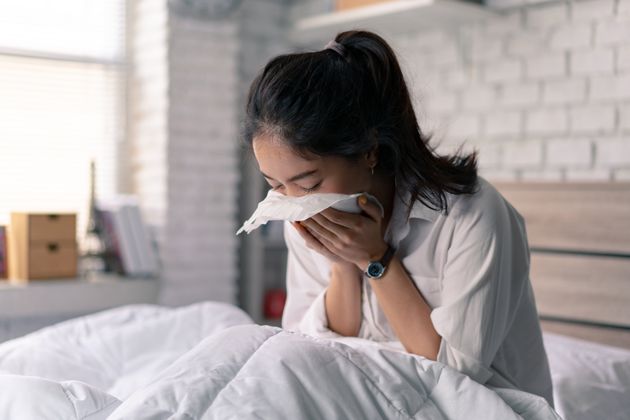’Tis the season for turkey trots, Black Friday sales and fighting over the last piece of pumpkin pie. Oh, and the flu.
According to the U.S. Centers for Disease Control and Prevention, 3% to 11% of people in the U.S. have to deal with the flu each year, with an average of 8% getting sick. And while the flu vaccine is a must, it still only reduces your flu risk by 40% to 60%, meaning it’s not a complete safeguard depending on your health, age and the type of flu virus you contract. (If you do contract the flu after you’ve gotten a flu shot, the vaccine will lessen the severity of symptoms and help prevent against flu-related complications like pneumonia. So it’s still important to get it.)
Here, flu experts share what happens once you’re exposed to the flu including why it triggers some of those unpleasant symptoms like fevers, aches and chills. Read on to learn, plus get some guidance on how to stay as protected as possible this flu season.

First, the flu has to find a way to get into your body
Simply being in the house with someone who has the flu won’t get you sick, but it can definitely increase your risk factor if you’re not practicing proper hand-washing hygiene.
“The virus has to find a way to get into either your nose or mouth,” said Amesh Adalja, a senior scholar at the Johns Hopkins Center for Health Security. “It’s usually transmitted from person to person through coughing, sneezing, or mucus or saliva that might be on someone’s hands. It can also be transmitted from common surfaces that people may touch. They may have wiped their nose and then touched their hands before putting it on a surface or may have sneezed on the surface.”
Your eyes and ears may be access sites as well, but Adalja said these are far less common entry points, so make sure you wash your hands often and well during flu season to prevent the virus from infecting you to begin with.
You won’t have symptoms right away once the virus enters your system
Once the virus enters your nose or mouth through direct contact (like being sneezed on, yuck) or indirect (such as using a towel shortly after an infected person has previously used it) the virus will make its way to your immune system, but this won’t happen immediately.
“Once the flu gets into your body, it will set up shop and cause the same infection in you,” said Aaron Glatt, chairman of infectious diseases and hospital epidemiologist at Mount Sinai South Nassau in Hewlett, New York. “The incubation period is about one to four days. On average two days, but it is still a highly contagious disease during this time.”
This means that you could be asymptomatic for a day or two but very much able to spread the flu to others without even knowing it.
Once the flu settles in, it’s heading for your cells
Specifically, the virus goes to your respiratory epithelial cells, which line your respiratory tract.
“The virus binds to sialic acids that are on these cells, and these sialic acids function as receptors to help the cells signal and communicate to each other,” Adalja explained.
The virus is able to bind to these cells thanks to a protein called hemagglutinin (which is what the H stands for in flu strains like H1N1). With the help of this protein, the virus attaches itself to the cell and then gets inside the cell, which will send an alarm to your immune system.
Some flu symptoms are from an immune system response
After your immune system figures out there’s a virus inside the body, it will go into overdrive to get it out as quickly as possible.
“As part of that, the immune response will start to ramp up some of the symptoms that you feel. Fevers, muscle aches and pains are the result of certain chemicals being secreted by the immune system in order to fight that virus off,” Adalja said, adding that a quarter of people with the flu have no symptoms. This doesn’t mean your immune system isn’t working, it’s just how you clinically present the virus.
Basically, your body becomes a battlefield when you have the flu and the reason you feel so terrible is from the war between the pathogen and your immune system, Adalja said.

The average shelf life of the virus is about a week
“Most healthy people have self-limited disease,” Glatt said. “They get sick for a couple days, or some people don’t get very sick at all. Other people get a mild illness or more moderate illness for a couple of days or a week or two at most.”
The standard run-of-the-mill flu in a healthy person typically doesn’t require treatment but certain groups are at a higher risk of developing complications from the flu including pregnant women, those with certain underlying diseases, children less than 12 months old, or adults over the age of 65.
Glatt said for these groups especially, it’s important to make an appointment with a physician as soon as flu symptoms come on. They’ll be able to prescribe an appropriate antiviral medication to help relieve symptoms and clear the virus out of your body as fast as possible. (This is also good general advice, as doctors can prescribe medications like Tamiflu to help reduce the severity and length of the illness.)
Other than that, get lots of rest, drink fluids and monitor your symptoms. While you may be miserable for a few days, your body will fight the flu the best it can.